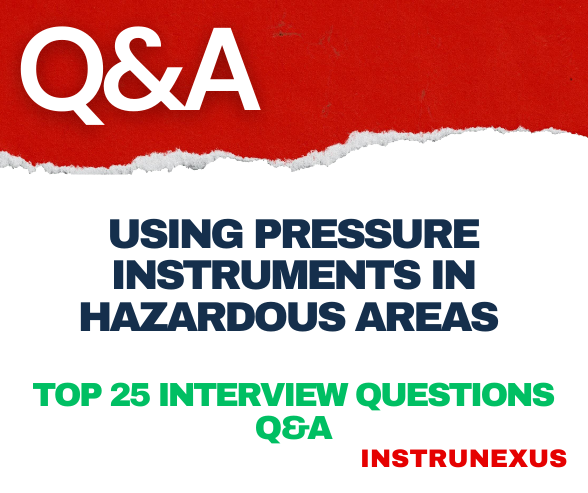
✅ Using Pressure Instruments in Hazardous Areas – Top 25 Interview Questions & Answers
1. What is a hazardous area?
A hazardous area is a location where flammable gases, vapors, or dusts are present in sufficient quantities to pose a risk of explosion or fire.
2. Which international standards govern the use of instruments in hazardous areas?
IEC 60079 series for explosive atmospheres
ATEX Directive (Europe)
NEC 500/505 (North America)
3. What are the main types of protection techniques for pressure transmitters in hazardous areas?
Intrinsic Safety (IS)
Flameproof/Explosion-proof (Ex d)
Increased Safety (Ex e)
Pressurization (Ex p)
4. What is Intrinsic Safety (IS)?
IS is a protection technique that limits the energy (voltage & current) in the circuit so it cannot ignite an explosive atmosphere.
5. What is the basic principle of explosion-proof (Ex d) enclosures?
They contain any internal explosion and prevent it from igniting the external hazardous atmosphere.
6. What is the typical output signal of a pressure transmitter used in hazardous areas?
Usually 4–20 mA, with or without HART communication. Must be compatible with IS or Ex d requirements.
7. What is the role of Zener barriers or isolators in IS loops?
They limit the energy going into hazardous areas and provide safety grounding paths.
8. What is the IP rating requirement for pressure transmitters in Zone 1/Zone 2?
Typically IP65 or higher is recommended to withstand environmental conditions and prevent ingress.
9. What is the difference between Zone 0, Zone 1, and Zone 2 areas?
Zone 0: Explosive gas is continuously present
Zone 1: Likely during normal operation
Zone 2: Rare and for short durations
10. Can you use an Ex d pressure transmitter in Zone 0?
No. Ex d devices are not allowed in Zone 0 as they are not considered safe under continuous exposure.
11. What is a flame path in Ex d enclosures?
A precisely machined gap that cools and quenches flames before they reach the outside environment.
12. How do you ground a pressure transmitter in hazardous areas?
Through intrinsically safe earthing or functional earth, ensuring low-resistance paths.
13. What is SIL, and why is it relevant for hazardous areas?
SIL (Safety Integrity Level) is a measure of risk reduction. It ensures instruments function correctly during a demand in safety systems (IEC 61511).
14. What is temperature class in hazardous area instruments?
It defines the maximum surface temperature an instrument can reach, ensuring it won’t ignite surrounding gases.
15. What are gas groups?
Gas groups classify flammable gases based on ignition energy:
Group IIA – Propane
Group IIB – Ethylene
Group IIC – Hydrogen/Acetylene
16. Why is certification important for pressure transmitters in hazardous areas?
Certifications (e.g., ATEX, IECEx) ensure compliance with safety standards and verify the instrument is safe for classified areas.
17. How do you select a pressure transmitter for a Zone 1 area?
Choose Ex d or IS certified device
Check gas group and temperature class
Ensure compatibility with control system loop
18. What happens if a non-certified device is used in a hazardous area?
It may invalidate site compliance, create safety hazards, and could lead to explosions.
19. What is the benefit of IS over Ex d?
No need for flameproof enclosures
Easier maintenance
Safer to work on live circuits (with proper tools)
20. How do you maintain a pressure transmitter in a hazardous area?
Follow permit-to-work procedures, ensure area is de-energized or use IS tools, and always follow manufacturer guidelines.
21. Can you perform live calibration in hazardous areas?
Yes, but only with IS-certified handheld calibrators and under controlled conditions.
22. What is the difference between Ex ia and Ex ib?
Ex ia: Safe for Zone 0, with two-fault tolerance
Ex ib: Safe for Zone 1, with one-fault tolerance
23. What is a gas ingress risk and how is it mitigated?
Risk of gas entering equipment—mitigated by sealed enclosures, proper IP ratings, and purging (Ex p) if needed.
24. What are common failure modes for pressure transmitters in hazardous areas?
Electrical faults
Seal failures
Overpressure damage
Moisture ingress
Loss of certification due to wear/repairs
25. What documents must be verified for pressure instruments in hazardous areas?
Certificate of Conformity (CoC)
Loop drawing with IS calculations
Hazardous Area Classification
Data sheet & SIL assessment (if SIS)
